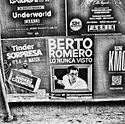There’s a set people like to test, I can’t remember the sequence right now. Something like a minute or two apart for the quickest times and then spread out further as developing time gets longer.
Something like 4, 6, 9, 13, 20
That sounds about right. I've been doing mine a little bit different, where I try to keep it based off of a 10 minute start time. For example, start at 10 minutes, cut the time by 25%, puts you at 7:30, cut another 25% (from 10 minutes, 50% total), puts you at 5 minutes. The time between 7:30 and 5 is 6:15, but I round down to 6 minutes flat (6 minutes is a pretty common dev time). Going the other way from 10 minutes, adding 25% is 12:30, adding another 25% (from the 10 minutes, 50% total) is 15 minutes, then 17:30, then 20 (assuming I need to go that far), etc..
I know it sounds strange to do it that way, but it only takes two or three data points where you changed the time by a certain percentage to see how much the middle gray density moved for that percentage of time change. From there, it actually starts to get very predictable, where I can guesstimate with a pretty high degree of accuracy how much time I need to have to put my correctly exposed middle grey at a certain density. From there, if I know it's under exposed, by a stop lets say, it's not that hard to start at one of my data points, look at the density for 1 or two stops over/under and make a relatively accurate estimate for what time it will take to get that up (or down) to where middle grey would normally be if correctly exposed.
You also know what the contrast is, though, the way I scan, that's less useful to me. My setup always puts the film base plus fog 6 stops below middle gray, then I have a standard tone curve that I use for most films that would put a correctly exposed grey card at 46.6% luminance in Adobe Lightroom, with the highlights topping out at 100% luminance 7 stops up from middle grey, for a total of 13-14 stops from pure white to as black as it's going to get. From there, it's a matter of knowing what time you need to have to make a grey card exposed however it was exposed sit at middle grey. If it was under exposed, then instead of 5-6 stops between middle grey and film base plus fog, you'll have 4-5, or less if you really under exposed it. The same goes the other way for over exposing. Your visible contrast will contract and expand as you adjust the time.
For films that have wonky tone curves, or if I need to do something very specific, I just make a tone curve for that situation and use that instead. The end goal is to always make the scanned image look normal no matter how it was shot or developed. Most people that send film in to be processed can't even tell you how they exposed it. It's usually something along the lines of "I put it in the camera and it worked". In those instances, I run normal time, then adjust the scanning tone curve to more or less contrast on the frames that need it. I have contrast tone curves from 0.24 to 0.92 gamma in 0.02 increments, with 0.40 to 0.72 gamma in 0.01 increments, so once you put the FB+F at -6 down, if the standard contrast doesn't look right (too dark or too bright), you just crank it up or down until it does. It's basically the digital equivalent to variable contrast paper where you get your max paper black then adjust the contrast until it looks the way you want it to. You can even get nutty and do things like make multiple versions at different contrast levels, stack them as layers in photoshop with layer masks then mask in and out the different parts you want to make a combination image that for example could have clouds where you dialed down the contrast to bring them down to less brightness, medium middle tones, and punchy as all get out shadows and blacks. Total sacrilege, I know. But if you do it right on that special image, it looks pretty awesome. I've probably gone too far outside of analog land for this thread, but this is very much the reason for doing a lot of this. A well executed analog print is a beautiful thing, but digital gives a lot more flexibility (and complexity), and with modern high resolution pigment printers and inkjet papers, well executed digital output quality can be very high. I've said enough.










